Letter From Puerto Rico
A reporter’s notebook on an unnatural disaster
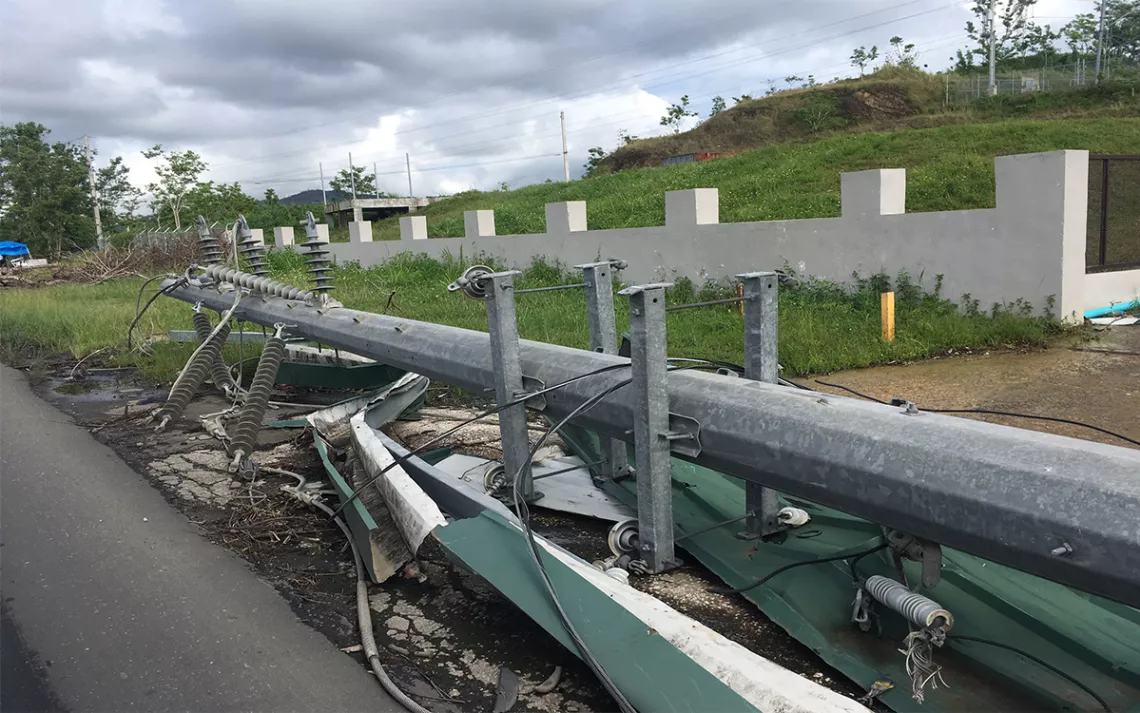
Downed power lines | Photos by Jason Mark
SAN JUAN—Two months after Hurricane Maria slashed across Puerto Rico, the power remains off in most places, and the whir of gasoline and diesel generators has replaced the island’s usual soundtrack of bomba, reggaeton, and salsa. The noise is nonstop. The brrrrring grinds throughout the day to keep barbershops, restaurants, and corner stores open; it grinds throughout the night as puertorriqueños turn on their home units to run some fans and a small lamp or two. In the all-too-dark capital of San Juan, the generators are so loud they even outcompete the co-Kee of the Coquí, the tiny yellow-green tree frog whose song normally fills the Puerto Rican night. (Coquí is onomatopoeia; the second syllable of the frog’s call rises inquisitively like California up-speak.)
On the mainland, people often hear stats about how much power is on here, depending on the day, or sometimes, the hour—35 percent one day, 48 another, 55 percent at best. But such numbers are too tidy to capture the reality of life without electricity in Puerto Rico. The blackouts are seemingly random, more like a blinking string of Christmas lights on a circuit that keeps popping: on-off, on-off, on-off . . . off. One neighborhood will have power, and then two blocks over it’s dark. After sundown, San Juan’s modern skyline is blotted into squat, black shapes.
I can count on one hand the number of functioning traffic signals I’ve seen on the island. At the busier intersections, police tirelessly direct traffic. At most others, collisions are narrowly avoided through a mix of courtesy, critical mass, and sometimes outright games of chicken. In the north-central city of Arecibo, a group of homeless folks have taken it upon themselves to manage the road crossings.
When people greet each other, pretty much the first thing they say is: “Tiene luz?” (Do you have light?) When I booked an Airbnb place in early November, my host’s page exalted, “The Power Is Back!” with cheesy lightbulb wallpaper. By the time I arrived, the power was off again, and it’s remained so for a week. This is in the posh seaside neighborhood of Condado, a short walk from chain hotels packed with FEMA workers and government contractors.
The situation in the countryside, of course, is much worse. In the mountain town of Adjuntas, there’s no power at all. The authorities say the lights won’t be back on until well into 2018. Locals are assuming they won’t have power restored until as late as May.
In a pink house not far from Adjuntas’s postcard-perfect plaza, a community group called Casa Pueblo has been giving out water filters and solar lanterns. The other day, a young man came in with a twenty in his hands, told the staffers that he had a baby at home and no lights, and asked to buy batteries. (Someone at Burger King had told him he could buy batteries there.) The Casa Pueblo people said they weren’t selling batteries. They gave him a LifeStraw water filter and a Luci inflatable solar lamp, and the guy walked out with the money still in his hand.
“A lot of people come here with needs,” Arturo Massol, the associate director of the community center, told me. Back in 2002, Massol’s father, Alexis, won the Goldman Environmental Prize for his leadership in stopping a proposed open-pit mine. In this current crisis, Case Pueblo is focused on distributing solar lanterns to local residents while also promoting community solar projects that will be more adaptable when future storms hit. According to Massol, Casa Pueblo has distributed close to 6,000 solar lamps to Adjuntas’s 18,000 residents.
“The thing is, with the solar lanterns you don’t have to pay to run them [unlike the generators],” Massol said. “And what we’re saying is that the renewable energy is better. In this moment of crisis, people who never thought about solar energy, because they had this impression that energy is infinite, are now finding that electricity can run out. And they’re seeing that, actually, it’s the sun that’s an infinite source of power. The solar lanterns are a way of convincing people with the facts.”
With the exception of the occasional passing truck blaring music and news, the high-ceilinged salon at Casa Pueblo was blessedly quiet, free from any generator racket. That’s because a bank of solar panels powers the community center. Locals were popping in and out to charge their phones on a collection of power strips. An elderly woman sat on a cushioned bench taking an oxygen treatment. “This is an energy oasis,” Massol said.
For Massol, as well as for just about every Puerto Rican I’ve spoken to while here, the grassroots response to the crisis has been the one bright spot amid the storm wreckage and the prolonged blackout. In the days and weeks after the storm, locals gathered in neighborhood brigades to clear away downed trees and branches, clean up the streets, and help each other dispose of possessions destroyed by the winds, rains, and flooding. People lent each other chainsaws and pickup trucks to get the work done. But restringing hundreds of miles of power cables? That, of course, is beyond any grassroots response.
“Everything that’s been done has been done at the community level. After two months, it’s become evident that the government’s response has been insufficient,” Massol said. “I think what Maria did is tear off the mask to reveal the social conflicts and the injustice and the poverty that divides Puerto Rico. And what the storm also did is show that we can’t wait for the government to address social and environmental problems. We can’t just sit here.”
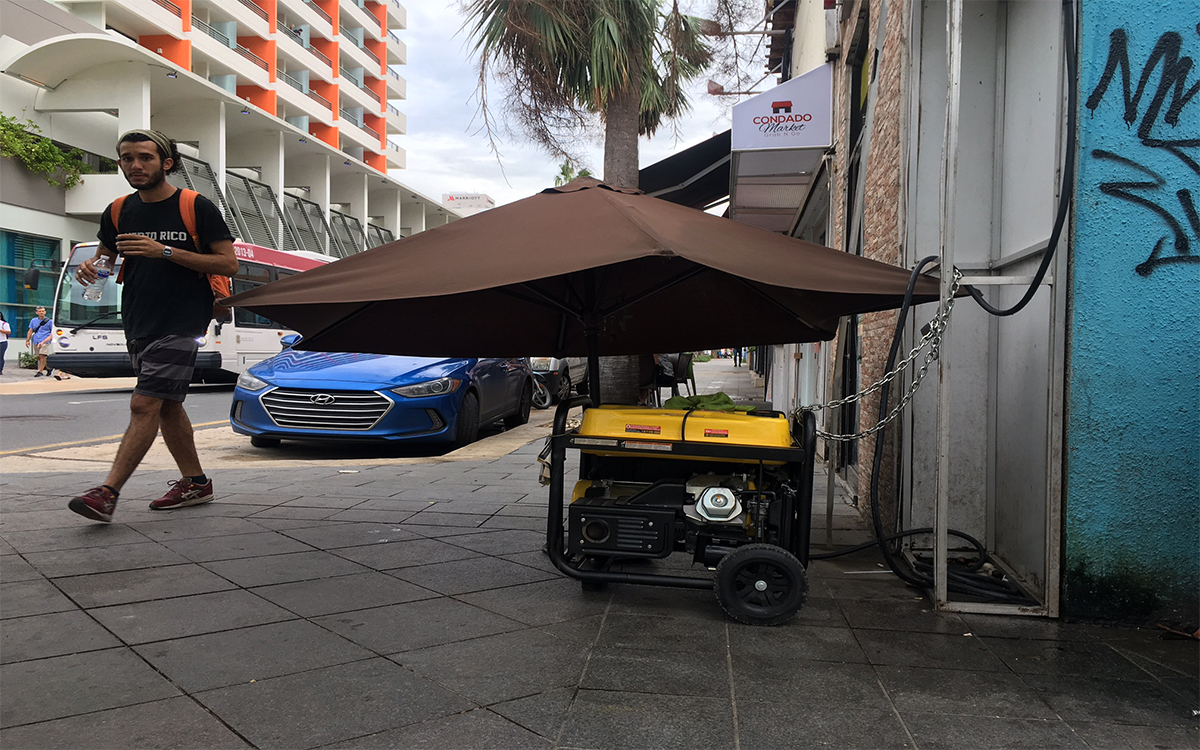
Streetside generator
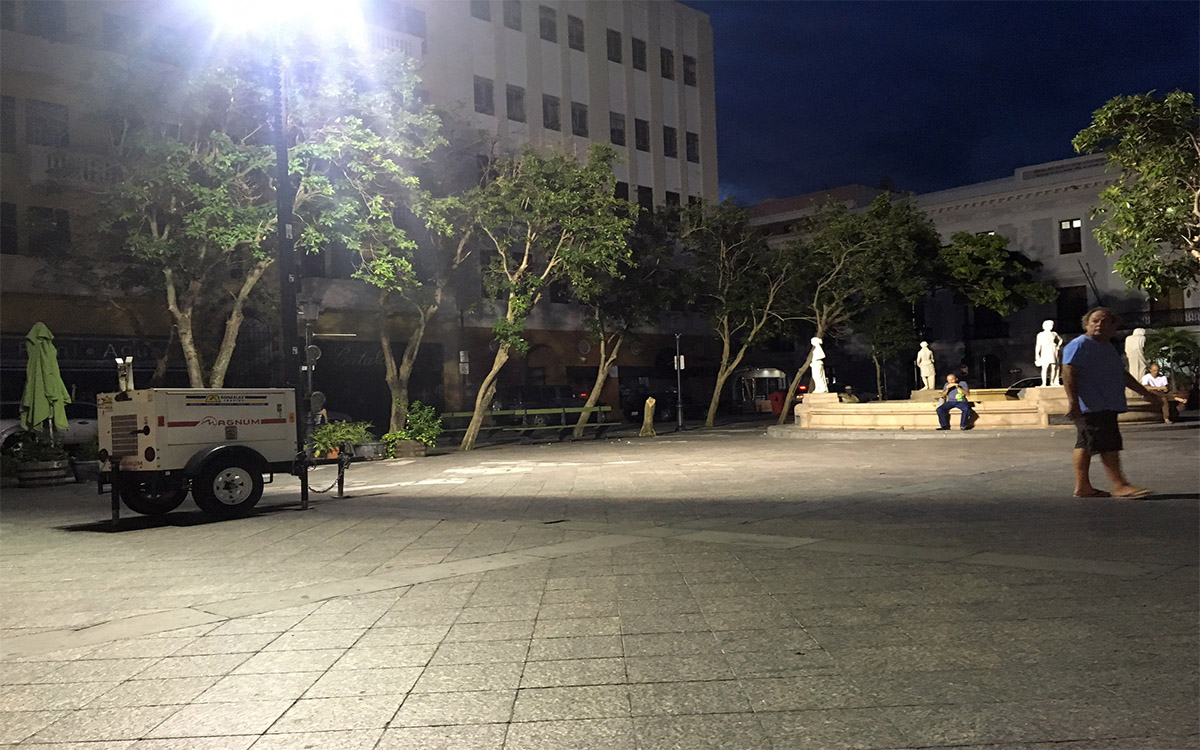
Light on wheels
*
The official death toll from Hurricane Maria is 55 people, but everyone here believes that figure is a joke. Tell someone that the government reports 55 people dead due to the storm and you’ll be greeted with eye-rolling.
But even if most people are certain that the official number is way too low, there’s little clarity about the actual figure.
Puerto Rico’s Center for Investigative Journalism (Centro de Periodismo Investigato, or CPI) compared official death figures from the 10 days immediately after the storm with statistics from the same time period last year and found that an additional 472 people passed away in late September measured against 2016. That’s a 43 percent increase in mortality. A subsequent investigation by the news organization identified 47 specific cases in which people died due to storm-related complications—primarily the power outages. (CPI is led by journalist Omaya Sosa Pascual, whose reporting on the crisis has been indispensable.) In late October, government officials acknowledged that, in the weeks after the storm, 911 bodies were cremated before a cause of death was determined. This revelation only deepened popular suspicion of the official figures. (One of the more ghoulish episodes of the past two months happened in early October, when portions of a hospital in the northwest corner of the island were briefly shut down after the odor from the un-air-conditioned morgue started to creep through the hospital.
Even as the media casts doubt on the official figures, the commonwealth’s government hasn’t budged on the official death count. On Friday, officials with the Department of Public Safety (the agency responsible for collecting mortality statistics and determining cause of death) wrote to me to say that they are open to revising the official figure and will evaluate any cases “and the evidence presented.” The state government’s figures on “direct” and “indirect” deaths “are based on CDC definitions,” officials told me via email.
This officious response is less than convincing.
In the south-central city of Caguas, I spoke with Dr. Enrique Robles, the medical director of an emergency room at a local hospital. In the weeks following the storm, his hospital was overwhelmed by the volume of people seeking treatment. In a normal month, Dr. Robles told me, his emergency room treats about 4,000 patients; in the month following Hurricane Maria’s September 20 landfall, his team of 22 doctors treated more than 6,000 people. Some injuries were directly storm-related: cuts from glass as windows blew out, a man who came in with his neck broken from a falling tree. Others were indirectly related to the storm: Many people came to the emergency room with lacerations from accidents using machetes as they cleared away fallen trees and brush; a 19-year-old man died in a car accident after all of the streetlights and stoplights went dark.
Then there were those who died as the blackouts persisted. Dr. Robles said that “people of advanced age” who were already suffering from chronic illnesses could not handle the stresses of the storm and the blackout-related hardships (the heat and humidity, especially, which aggravated pulmonary diseases) and succumbed. Some people who were on kidney dialysis died due to a lack of clean water for their treatment and the inability to run the dialysis machines. On a single day in the week following the storm (Dr. Robles couldn’t remember exactly which, as he said the whole week was a blur), seven patients in the intensive care unit died within two hours as the hospital’s oxygen machines failed when there wasn’t enough electricity to sustain pressure in the lines.
When I floated the 472 storm-related deaths figure and asked if it seemed possible, or too low, Dr. Robles took a deep breath, looked down at his hands, and shook his head: The number seemed too low. “Seven people dying in one day in only one hospital,” my Puerto Rican photographer said. “Exactly,” Dr. Robles said. “And this happened in many other places on the island.”
(In response, the Department of Public Safety said that it was a “little irresponsible” for the doctor to offer his “belief”—they put the word in air quotes—that the official number is inaccurate without “pertinent investigations.”)
When I asked how it felt to witness a patient die who might otherwise have lived longer had it not been for a technical meltdown, Dr. Robles said, “Frustrated. Powerless.”
*
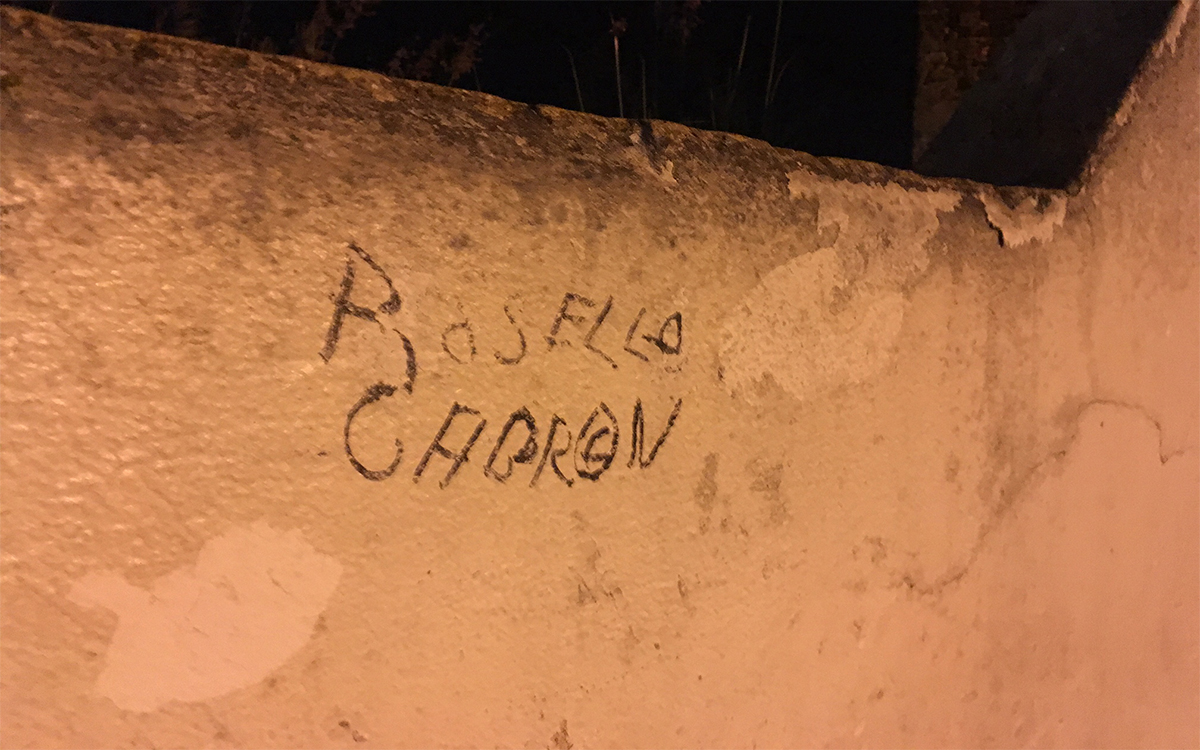
Political graffiti two blocks from the governor's mansion
People are seething-mad at the island’s political leadership. The vast damage wrought by Hurricane Maria occurred in a mere 24 hours, but the worst harms, most people agree, have happened in the 60 days since, as the Puerto Rican government has struggled to restore basic services. There are the immediate damages: the loss of lives and also the loss of livelihoods as the blackout has shuttered thousands of businesses and cast hundreds of thousands of people into temporary unemployment. Then there are the larger, if harder to grasp, harms: the further erosion in the public’s trust of government.
“What we have learned from Maria is that there is no government, and that’s fucked up, because you need civic institutions,” a guy named Waldemar Alcobas told me. Alcobas used to have an eco-tourism lodge called Ruta Nativa in the mountains outside the community of Barceloneta, but it was totally wiped out by the storm. Now he’s beginning to rebuild even as he waits for assistance from FEMA. “People are doing incredible things with their own hands, without any government help.”
The mayor of the southeastern city of Humacao, speaking on one of the main morning radio news shows, captured the popular sentiment when he told listeners, “We’ve been abandoned.”
Though there are, to be sure, gripes about the federal response (especially President Donald Trump’s grotesque show of tossing paper towels into a hand-picked crowd of the well-to-do), most of the finger-pointing is directed toward the governor’s mansion in old San Juan.
“I would have expected a more diligent response,” a local environmental activist, Luis Jorge Rivera Herrera, told me over coffee my first morning on the island. “But it hasn’t been FEMA’s or the federal government’s fault. It’s been our fault. . . . We built this disaster. Since the Spanish conquest of the island, we know that we are in a hurricane alley. There is no need for us to have developed the island in the way we have done it.” A little later in the conversation, Herrera said, “Before complaining about the federal government, we have to have a very hard look into ourselves.”
Herrera’s demand for local accountability is understandable. The U.S. government, however, also bears a large measure of responsibility for the crisis here, especially given Puerto Rico’s “complex relationship as a colonial territory of the United States,” in Herrera’s words.
When navies mattered more, Puerto Rico was a strategic necessity for the United States. Here’s Rough Rider (and legendary conservationist) Teddy Roosevelt writing to a U.S. senator in the midst of the Spanish-American War: “I earnestly hope that no truce will be granted and that peace will only be made on the consideration of Cuba being independent, Porto Rico [sic] ours, and the Philippines taken away from Spain.”
One hundred and nineteen years later, Puerto Rico is still “ours”—a commonwealth in name but a colony in reality.
The island is $70 billion in debt, and in 2015 its bonds were downgraded to junk status after it defaulted on a bond payment. In response, President Obama and the U.S. Congress established a seven-person oversight board to manage the island’s finances. The junta, as everyone here calls it, meets in New York City, and six of its seven members are appointed by the president. So while Governor Ricardo Rosselló and the Puerto Rican Congress are, officially, the ultimate political authorities, the real power rests with the junta, which has final say over the island’s budget and spending.
As the debt crisis continues, the Puerto Rican government has been stretched nearly to death on the rack of austerity. The government has been forced to raise taxes and slash government spending even in the midst of sluggish economic performance (the island really never recovered from the Great Recession). In May, the government closed some 180 schools across the island as part of its efforts to reduce public spending. According to what I heard from a member of the electric utility’s union, the number of utility employees has fallen from a height of 10,000 to 3,500 today. No wonder the island’s grid was a mess even before this season’s hurricanes. It’s hard to keep the lights on when you don’t have sufficient staff to get the job done.
In a recent appearance on Capitol Hill, Governor Rosselló said it will cost nearly $95 billion to reconstruct the island’s homes and infrastructure and to cover the costs of storm-related job losses.
The Trump administration is offering a fraction of that.
*
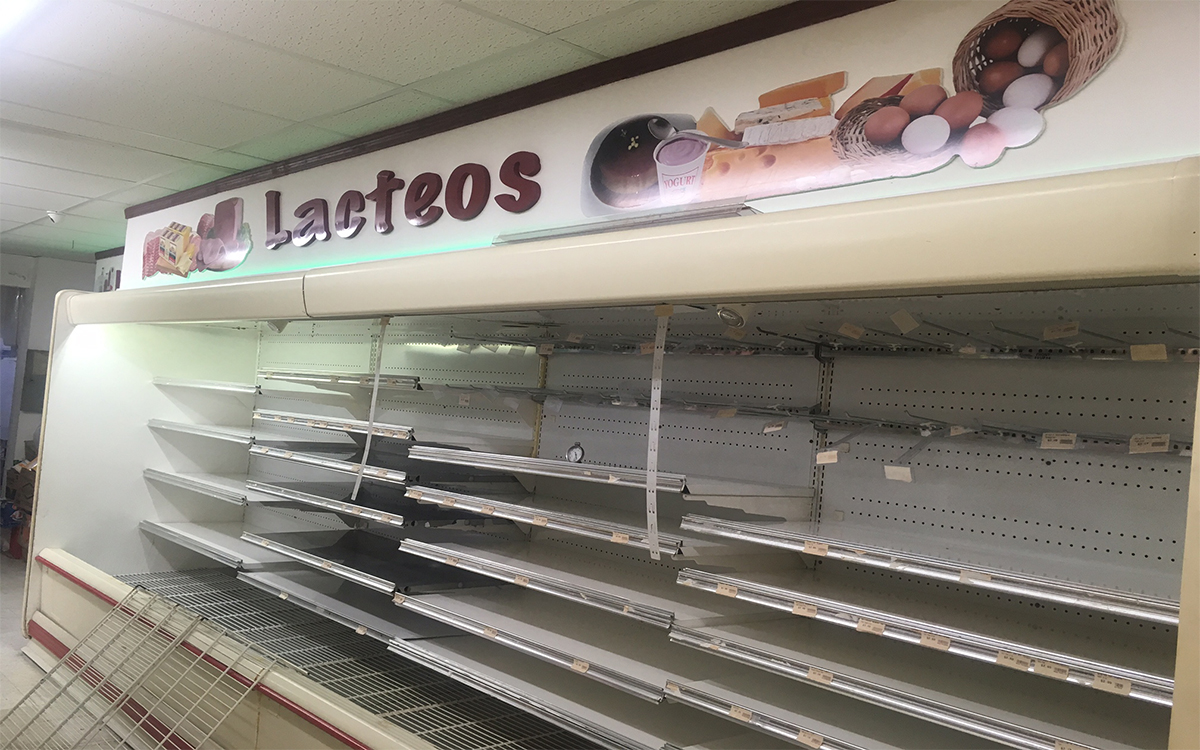
Empty grocery store shelves
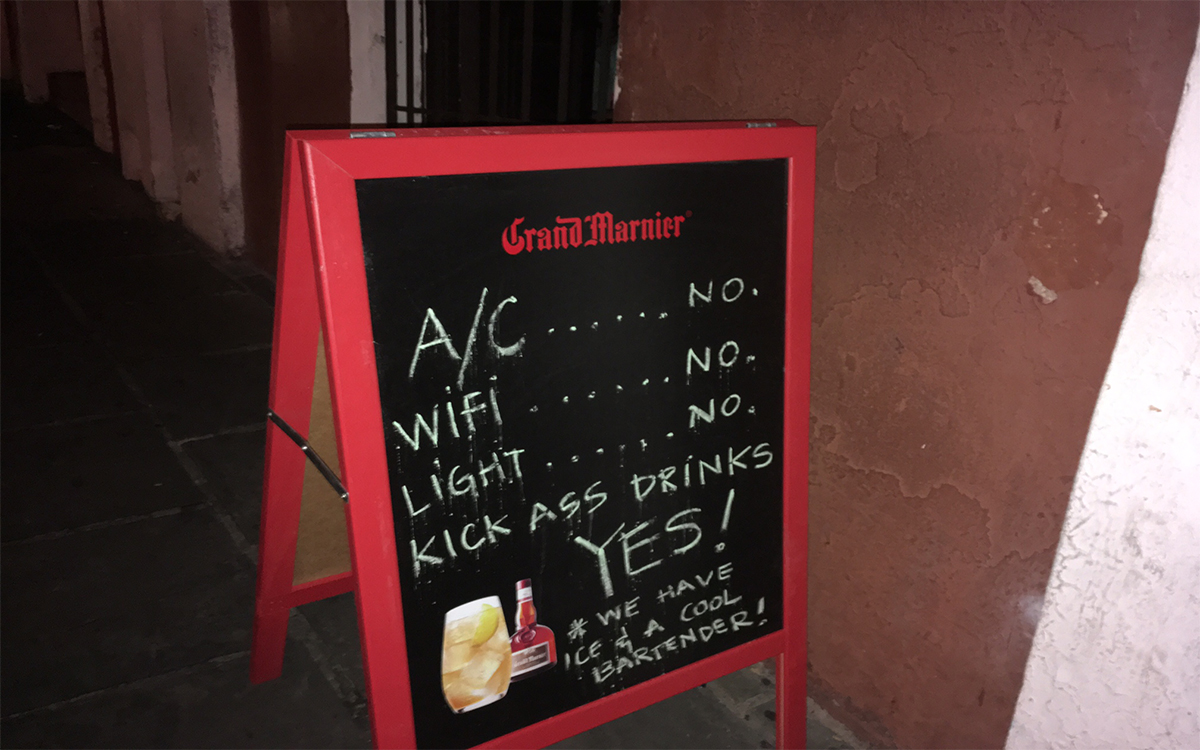
Sign outside bar
In the weeks immediately after the storm, there were lines for everything. People stood in the blazing sun for hours waiting to get some cash from ATMs. Lines of cars stretched for miles as people scrambled for fuel. One dude, a singer named Juan who fronts an Afro-Latino rock band called La Quilombera, told me about waiting 10 hours for gas—only to be the third car in the queue before the station completely ran out.
People have cash now, and fuel, but there’s still a lot of waiting. Almost every fast-food joint (and a lot of the sit-down places, too) has a line for service. With the power so sketchy, few people are able to eat at home. After all, it’s hard to keep food when the fridge is off for most of the day, and it’s no fun to cook in the dark. So everyone goes out to eat.
Perhaps this is a modest hardship. But consider the costs involved. People are suffering from weeks (or months) of lost wages as their businesses remain closed. And even as their earnings shrink, the costs continue to rise, what with all the money people are shelling out on gas to keep their generators running. The restaurants might be booming, but for most locals the extra spending is yet another financial stone around the neck.
This is how my Airbnb host, a freelance videographer who’s getting by with a temporary FEMA gig, summed up the situation: “This whole thing is super jodio [fucked up] for the economy.”
*
Almost everyone has some kind of cellphone video of the storm (la tormenta, en Español). Even on a tiny screen, the scenes are harrowing. The saltwater-filled winds scoured concrete like a sandblaster. Trees were torn out of the ground, the biggest ones most often, and fell with a crash. For nearly 20 hours the wind blew fiercely.
“It was like someone was hitting your house with a strong stick,” a woman in Caguas told me.
“It was like the devil was banging on your house,” a San Juan artist said.
“Rocks were rolling down the mountain and landing on my house,” an 84-year-old woman in Adjuntas said. “It was terrifying.”
The next day, Puerto Ricans awoke to a world that was unrecognizable. Across much of the island, the trees were stripped of their leaves, leaving the normally lush forest brown and barren. Pictures from Yunque National Park showed a rainforest that had become a tumble of downed trees.
But nature is resilient. Already, the forests are coming back. In 60 days, all the leaves have returned. In fact, these tropical forests are hurricane-adapted, just as the woodlands of the mountain West are conditioned for fire. “With the passage of the hurricane, and the effects on the forest cover, it’s a natural process,” Arturo Massol told me. “The trees fall or lose their branches, opening up light into the forest. It’s part of the dynamic.”
Humans’ industrial and political systems have proven themselves far less resilient and adaptable—with one significant exception. The one sector that has responded with impressive speed and efficiency is the telecom companies.
In the wake of the storm, most cellphone towers were lying in crumpled piles, and people were going nuts. They couldn’t reach their friends and family. They didn’t know whether their loved ones were OK. And like any good Americans, they were jonesing for the constant updates and posts they had come to expect from just about everyone in their lives. As one puertorriqueño put it, not having any cellphone or internet service made him feel “demented.”
Now the telecommunications have been restored to most of the island. The cellphone towers have been rebuilt and repaired and are running on generator power until the grid is stabilized. Once again, people can exchange Facebook posts and YouTube videos and political satire memes. Even if there are no lights on in the house, people at least have the blue glow of their phones back.
*
The talk on the street is that this crisis, awful as it has been, at least offers an opportunity to remake Puerto Rico into something different. A place, ideally, that’s more ecologically sustainable, more socially just, and more self-sufficient. “The people who will have the hardest time going forward are those who resist change,” a professional Flamenco dancer named Josette told me. “Because things are already changing.”
When I think about how Puerto Rico might evolve, I keep flashing back on something the emergency room doctor in Caguas told me. I had asked him if there were any lessons he had learned from this experience, and his response surprised me.
“I’ve learned to have patience,” Dr. Robles told me. “With hindsight, I think I can see that we need to develop a more pure kind of medicine.”
I asked what he meant by a “more pure” style of medicine.
“With modern medicine, the doctor is always asking to receive 20 X-rays, blood work, et cetera. But sometimes all those resources are limiting. During the storm, we ran out of tetanus shots, we ran out of fluid, we ran out of sutures for closing wounds. And we had to return to a more personal kind of medicine. A more simple style of medicine. Without X-rays, I had to resort to a kind of patient-evaluation that was more personal. Still professional, but more intimate. I had to reach out and touch the patient, I had to scrutinize the patient more carefully, I had listen to the patient. And that’s the style of medicine I’d like to try to practice.
“I used to be really impatient. If I didn’t get the X-rays on time, or the blood work on time, I’d be very unsatisfied. Now, I’m trying to be more patient.”
Patience. That’s the quality of being, so challenging for us ultra-wired moderns, that we’ll need in order to weather the storms that are still to come.
 The Magazine of The Sierra Club
The Magazine of The Sierra Club



